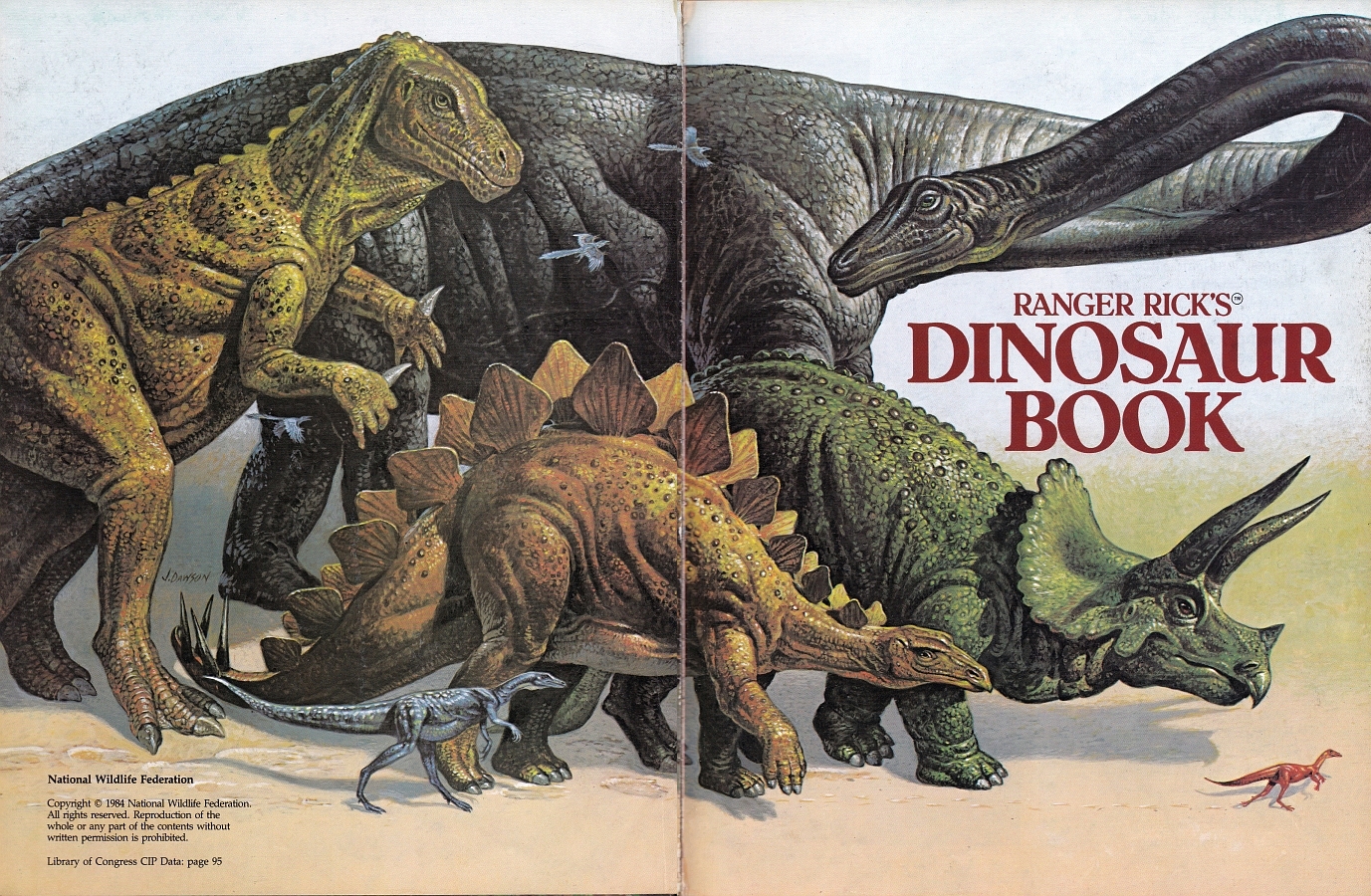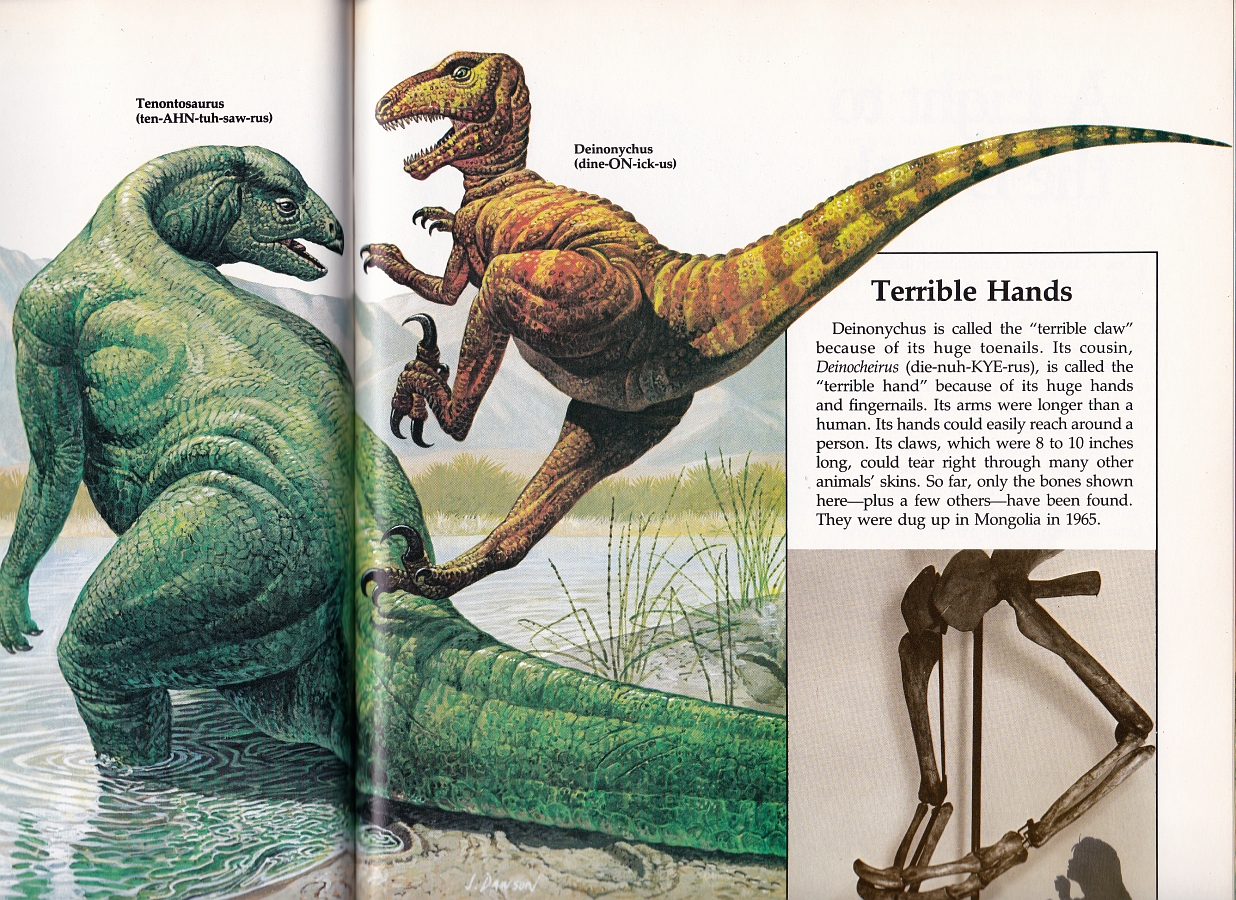Now here’s a blast from the past, and in more than the usual multiple senses – for David took a very brief look at this book back in 2010. It’s a measure of just how much things have changed in a decade that David’s post now seems incongruously short – just a smattering of pics from Flickr, shared by the wonderful Trish Arnold. That does mean that there’s an awful lot left to explore in Ranger Rick’s Dinosaur Book, and praise be to Herman Diaz for sending me a copy. Published in 1984, it’s a curious mix of more retro-looking artwork by well-established illustrators (who weren’t necessarily dino-specialists) and much more modern-looking pieces by the likes of Hallett and Kish. (There are also a few Zallingers thrown in, for some reason.) In this post, I wanted to focus more on the former – specifically, the work of John D Dawson, a prolific wildlife illustrator whose oddly cheerful-looking T. rex greets us on the cover.

I must confess that, as a Brit, I’m entirely unfamiliar with the Ranger Rick magazine. Wikipedia describes it as a “children’s nature magazine” published by the National Wildlife Federation, a US conservation non-profit. It would appear that Dawson’s work appeared in Ranger Rick on a number of occasions, which – as a fine wildlife artist – is quite understandable. On that basis, it’s to be expected that he would be asked to paint dinosaurs for this book. I’ve noted in the past that wildlife artists who are commissioned to illustrate dinosaurs often turn in work that, while a little (or sometimes, very) behind the curve scientifically, is still beautiful and convincing-looking; after all, they tend to have an intuitive grasp of anatomy and a sense of what features a living, breathing animal should have.
Unsurprisingly, I feel that’s very much the case with Dawson’s work here. I’ll get back to the cover T. rex (‘cos it pops up later on), but while my first instinct is to regard it as a ’70s throwback, it’s worth stopping to admire all the fine, naturalistic details – the scalation and coarse, cracked skin give the impression of a tough creature with a thick hide. Bonus points are awarded for the freaky 1980s Quetzalcoatlus-thing flying overhead.

A Zallinger tyrannosaur greets us upon opening the book, but on turning the page again we come upon a parade of Dawson dinosaurs on the title spread. A particular highlight here is the Iguanodon stage right – with its upright posture, big ol’ dewlap, crenulated spines and underdeveloped hands, this incarnation of Iguanodon is virtually a character in its own right, almost as much as the Crystal Palace behemoths. (We can probably blame Neave Parker.) In spite of how it impossible it is to view this take on Iguanodon as anything other than an historical relic, Dawson uses all his skill to sell it to us as a real animal. There’s something that just looks so right about those fleshy neck folds and lizardy lips, even though we all know the animal should sport a beak.
Much the same is true of the other creatures, too. The Triceratops is a hopelessly outdated humpback straight outta Chaz Knight’s sketchbook, but its glistening scales (with rows of raised scutes) are superb. Shame the ear’s in the wrong place, but you can’t win ’em all. Stegosaurus, meanwhile, has about the right number of plates and appears relatively perky, and the sauropod looks like a suitably massive wall of muscle and flesh, rather than just being a fat blob. Just look at those shoulders. I haven’t felt so intimidated since a rather robustly built gentleman appeared in the park opposite my home and started lifting weights.

Here’s that tyrannosaur again. With its croc-like mouth, slightly crooked teeth and green colouration, it’s almost a vision of what that famous Papo T. rex toy (that’s become a stock image for no good reason whatsoever) would have looked like in the 1970s, before all tyrannosaurs had to have JP-style Angry Eyebrows. Behind Rexy is a wonderful collection of retro palaeoart tropes, including water-splashin’ hadrosaurs, copious ferns and horsetails, and an absolutely adorable squat little ankylosaur. It’s gorgeously painted (I love the ripples and reflections on the water) and so perfectly evocative of a certain era of dinosaur pop culture.

Rexy and his ankylosaur and hadrosaur friends appear once more on a spread looking at dinosaur sizes. Again, while the animals look very retro at first glance, they are also (mostly) pretty muscular and not bloated-looking, contrasting with the Zallinger and Knight pieces that also appear in this book. It’s likely down to a combination of Dawson’s anatomical knowledge as a wildlife artist, and the rapid progression of the Dino Renaissance. In fact, the Parasaurolophus – with its horizontal posture – manages to look rather more ‘modern’ than it did in the last illustration. Rexy, meanwhile, is a little awkward-looking, with a very large eye pointing the wrong way and oddly positioned arms that look like they should be holding a sign up. All sins are forgiven, of course, for the crouching ankylosaur that’s just SO CUTE D’AWWWW. It’s like the corgi of ankylosaurs. These days ankylosaurs are mostly depicted looking threatening and beating up anything that gets near them, but back in the day, they were much more lovable.
In case you were wondering, the animals here are labelled thusly: 1 – Tyrannosaurus, 2 – Ankylosaurus, 3 – Rhamphorynchus, 4- Alioramus (yes, really!), 5 – Struthiomimus, 6 – Parasaurolophus, 7 – Brachiosaurus, 8 – Rutiodon (don’t ask why), 9 – Leptoceratops. Alioramus is an unusual inclusion for a book of this vintage, and I must concede that it does look very odd, and does have very wasted-looking leg muscles. Can’t argue with the yellow stripes, though. They’re natty.

Less natty is the hideous skull face of this Cynognathus. Clearly, the impression being given here is of a not-quite-mammal that might still show more ‘reptilian’ traits, but even so, giving the creature a monstrous croc-like maw doesn’t make any sense. Plenty of artists did it – some of Stout’s prehistoric mammals were considerably more disturbing than this, and Basilosaurus has often been depicted as lipless – but there was simply never any reason for it. The shrinkwrapped skull and sparse tufts on hair conspire to make this creature look like it’s stumbled through Seth Brundle’s matter transporter.
Still, ugly as that animal is, one can’t fault the careful attention to detail in this piece. The way in which mud has caked the limbs of the Cynoganthus is a fantastic touch, superbly executed. I’m also very fond of the murky, muddy environment in which this is taking place; it makes a refreshing change from the normally ubiquitous Triassic Desert (as mentioned in the text).

Dawson’s next piece depicts a herd of Apatosaurus in which, intriguingly, the juveniles are coloured differently to the adults; a perfectly plausible scenario that seems to hardly ever be explored. Typical of the time, the animals depicted lack the characteristic chunky Apatosaurus neck, but at least they manage to avoid simply being reconstructed as ‘Diplodocus, but with more unwanted fat than the White House’. The diplodocid heads are also welcome. The animals’ skins are interesting in that, while sporting thick folds a la Gurche or Sibbick, they’re also clearly scaly – so another point for Dawson, there. The scene could perhaps have done with some indication of the scale of these creatures (such as a tree or some other animals), but I rather like it anyway.

Next up: corythosaur battles! Now, these fellows do look very 1970s – the tottering tripods in the background resemble old Airfix model kits. But they’re very charming with it. In fact, there are a few things I like about this piece beyond its nostalgic appeal. There’s the fairly subtle sexual dimorphism, for starters, with the battling males in the foreground distinguished by red crests and a red line down their backs. The scales on the animals’ hides are perhaps a little large, but a good impression is given of what dinosaur skin was like (unlike in, say, the Normanpedia). Finally, I very much appreciate the Corythosaurus‘ tail being used as a weapon, in spite of its lack of spikes or clubs. The tails of large dinosaurs are often imagined by people who don’t know better as dead weights or simple counterbalances to the front end, but they were actually hugely muscular and played an active role in locomotion, much as in living lizards and crocodiles. Dave Hone recently mentioned (in the Terrible Lizards podcast) how a strike from a lizard’s tail can be surprisingly painful – so just imagine what a large hadrosaur’s tail would have been capable of (never mind a sauropod’s).
So – more hadrosaurs battling or defending themselves with their tails, please.

And finally…this Deinonychus doesn’t half remind me of Peter Snowball’s (but mirrored). Tenontosaurus just doesn’t care any more. “Yeah, yeah, get it over with…”
Ranger Rick’s will return!







3 Comments
Marcello
June 11, 2020 at 6:19 pmThe condescending expressions of all the dinos in the Iguano pic are extremely unsettling. and the guys in the Rutiodon pic are just disgusted… Do the author wanted us to feel guilty for being mammals? I’ve a phylogenetic crisis now
markflessa
June 26, 2020 at 12:01 amI’m glad you included this book/magazine. While you Brits may be unfamiliar with it, “Ranger Rick” was a big part of my childhood and a played a significant part of me growing up with an interest in the natural world. I can’t wait to see the rest.
Stepan Jindra
July 17, 2020 at 8:03 amThe “selfie” Rex is hilarious. Shamely it remains secret how the selfie was taken with his tiny arms.